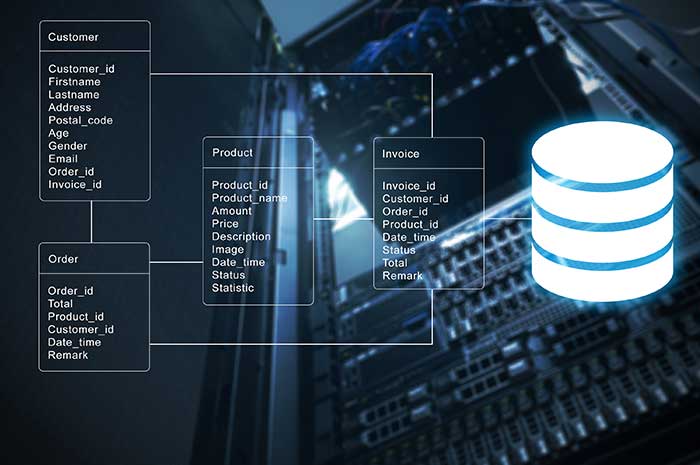The Cost of Bad Data
Who’s in charge of your CIA? Who gets your CRM and your marketing automation system to synchronize with ease? Who defines your data dictionary?
Let’s explore how bloated data costs you in real terms. One cost is direct; most CRM costs are defined on a per-name basis, and a database full of invalid names is like a property with vacant spaces to fill. If you’re the property owner, each of those unused spaces costs you money while returning no revenue. You can automate your data governance and synchronize your data using an automated API process based on time, events, data age, and data content. Automated data governance acts as a sort of property manager, ensuring that each of these spaces is filled where possible, and eliminated when necessary. By defining match codes, pieces of data that are used to index information, and conducting merge/purge operations with these fixed indices in place, a data governance strategy ensures that the only information your MARKETING AI® eliminates is the unwanted kind — duplicate names, invalid addresses, and other data bloat. Cleaner data from the outset populates your list with high-quality leads.
Data doesn’t exist in a vacuum. It’s contextual, especially if it’s behavioral data. That’s why a MAS installation is not the same as implementation, and why even automated processes need a data governance manager (DGM) to set the rules of the universe in which your MARKETING AI® does its work. When properly set up and maintained, your MAS is an active participant in automated data hygiene and enhancement, not just a tool. A MARKETING AI® helps you and your DGM identify duplicate records, reduce bloat, and spot opportunities when the data landscape changes, as it inevitably will.
Set Your Data Hygiene Rules
Before you touch your current database, you need to define your standards for list hygiene. Your MARKETING AI® is a system that relies on reinforcement learning to understand its environment, so defining that environment accurately with a complete, well-constructed data dictionary is critical. Consider the following questions and use them to show your MAS which data matters most:
- What is your database’s current state of health? Is your database cleaned regularly throughout its existence, or is it long overdue for a thorough scrubbing?
- What are your minimum standards for deliverability? You may find, as many business owners do, that your records follow the 80/20 rule — that is, the 20 percent of your customers with the most complete records account for 80 percent of your sales.
- How complete must records be to stay in the database? Fragmentary records don’t give your marketing AI enough information to make decisions about how to nurture these leads. By cross-referencing records and filling in the blanks with data appends, your automation system is able to respond to what your customers need, giving them the right information at the right time.
- Where are your breakpoints for information recency and activity? In some industries, orders are large and infrequent. Others rely on frequent but smaller sales. Your answer to this question determines when your marketing automation system moves older records to a different nurturing flow or archives them altogether.
- What information should you request? Email addresses that can be used in a nurture campaign or serve as match codes are of high importance, while phone numbers and social handles might be lower on your priority list.
- How do you acquire your data? When using a MAS, you’re already compiling some information on your customers via browser cookies long before they become customers. But setting constraints on the information you get from your contacts can result in more sales-qualified leads. For example, prepopulated forms are a nice convenience for visitors, but they introduce errors and outdated information into a database. It’s better to require input of some fields or have a set schedule for erasing prepopulated information so users re-enter current data. This new information then gets normalized and linked with the appropriate lead’s account.
- Which data should you use? Some prospects use multiple information sets, and your MAI needs to use the data your customers prefer. It’s a good practice to create more than one field for email addresses, for example. The first field contains the original email address that was initially provided by the contact. The other, a field labeled “preferred email address,” contains the most recent email address provided. Your marketing AI can then match the two fields to confirm if it is a new email address or a duplicate according to your CIA rules. Keep in mind that your marketing team can redefine the environment for the system, so it’s flexible. If you find you haven’t sufficiently pared records for frequency and recency to result in cleaner data, for example, you can adjust these parameters.
Cleanse Your Database
For most companies lead generation is the costliest aspect of their marketing department’s activity. According to a Marketing Sherpa survey, more than 64 percent of responding companies said they invested greater than $20 per lead, and more than one in three invested over $100 per lead. Those are startling figures, but they become even more shocking when you realize that the greatest impact of inaccurate or inactive data is on lead generation. Few companies can afford to throw those efforts away, and fewer still can afford to miss out on a host of potentially profitable leads because of an ISP blacklist.
Discovery depends on clean data, and clean data should have regular check-ups. With marketing automation, you’re able to set regular times and triggers for updates and health checks. All data has a natural decay rate, but frequent contact-data checks and automated updates offset that decay and preserve important information. Database hygiene and management tools now track people’s movements to new homes or jobs, merge information when it’s inadvertently duplicated, and identify records that need attention. The message is clear: Clean data costs less and delivers more.
If you had to hunt down and remove inaccurate and inactive data on your own, you’d spend years on even a small customer list. Thanks to automation, the process now takes an afternoon or so. Like most maintenance tasks, database cleaning has a multipoint inspection system that ensures cleanliness. Following are seven key elements that marketing automation experts examine when assessing a database’s health and keeping it clean.
- Deliverability – Ideally, all your mail, email, and phone correspondence would reach the person you wanted to find every time you reached out to your customer. In the real world, that’s rarely possible, and larger databases inevitably have a few undeliverable results. You and your marketing team can determine what your expected deliverable rate is, but 90 percent for direct mail and 95 percent for email is a good starting point. If you see deliverability rates lower than these, your database is overdue for pruning.
- Lead Generation – Are messages designed for lead generation increasing or decreasing in effectiveness? A decline in lead-generation rates could indicate lax database hygiene.
- Reputable Partners – If you’ve built your own list, you know how much time and effort goes into it. One way to instantly increase your marketing reach is through reputable list-brokerage companies. Choose companies that have a proven record of good data husbandry for your list rental. Using reliable sources that practice excellent list hygiene results in valuable new leads without concerns about low delivery rates and hits to your reputation.
- Hard and Soft Bounce Records – A hard bounce means email is permanently undeliverable. It usually means the email address doesn’t exist or has been closed. Typically, names that result in a hard bounce immediately come off the list. Soft bounces are more complex; they mean the email wasn’t deliverable at this time but may make it through on a subsequent attempt. A soft bounce can happen for a number of reasons: Temporary loss of service on the user’s side or a full mailbox are two possibilities. But they also need to be watched closely. Best email practices dictate that three or more consecutive soft bounces should result in removing the address from the active database.
- Sender Scores – ISPs have a keen interest in protecting their users’ in-boxes, so maintaining a high sender score is paramount. Fewer hard and soft bounces from undeliverable or blocked addresses raise your sender score. Higher sender scores mean a better reputation among ISPs, and a sterling reputation is your invitation to your prospects’ email as a trusted source. Your marketing AI monitors your daily sender score for you, tracking key performance indicators such as delivery rates and inbox penetration.
- Duplicate Data – Duplicate information is sometimes introduced into databases. It can happen when improperly synching with your CRM or when whole lists merge. Other times, duplicates come from users who forget a password or sign up under a different email address. Merging and purging processes keep incremental information and remove the duplicates, keeping your list compact and compliant with your data-governance rules.
- Updates – When a customer moves or forwards mail to another address, updating that information is vital to getting messages where they need to go. Updating records is also vital for effective data appending services, a key aspect of data enhancement.
- Recency – Older information that has had no activity can go in a couple of different directions. With some of your best customers, you may want to roll records into a slow-drip retargeting campaign. With others, you will want to warehouse information. Over time some of these records can become active again, but even if they don’t, that data’s useful for research. No data is ever wasted. You will also breathe fresh life into these leads by using a data-append service to validate the current postal and email address or append a new one.
Data Enhancement — Append and Reverse Append
Serving relevant content is key to successful marketing. Information that lets you identify common traits between your prospects and your best customers is hard to identify without the data that forms a complete picture. Relevance is king, but how do you establish it? That’s the purpose of the discovery process, and one of the most powerful tools at your disposal is data appending. A specific form of data optimization, appending matches the information you already have with information on a third-party database to build a more complete view of an individual
customer. Appending matches company name and postal addresses to active emails; reverse appending uses email addresses to append street addresses, phone numbers, and firmographic information.
In most cases, email is the most cost-effective solution for connecting with your prospects. Physical mailing addresses also contain a tremendous amount of valuable data. Appends bring these key elements together to enhance the power of each. Customers who once only connected with you in one area now receive impressions via additional marketing avenues — a key tenet of omni-channel-marketing strategies. Every bit of data you discover through appends not only improves your chances of connecting with your buyers, but it also gives your marketing automation system another means to cross-reference and fill in additional blanks.
Reliable, consistent data gives you reliable, consistent results. By profiling your data against an existing database and against other files within the system itself, you’re able to weed out invalid data and leave only relevant information. Inefficient or undersized append services can’t cross-reference data the way a larger, more powerful system can. You need a large pool of data — think tens of millions of names, not tens of thousands — to get the most out of appending, but it has the power to teach your marketing AI a wealth of new information.
Tracking People in Motion
Conventional data collection works solely to amass information and makes only a rudimentary attempt at analysis. It doesn’t track people as they move through a marketing and sales pipeline or open a window on how they interact with your brand over time.
Let’s look at our test case once again. As SEO Schematics’ executives make the move from siloed marketing systems to a complete marketing AI using the CIA process, they gain a new perspective by bringing time and motion into their analytics. Instead of seeing how many people visited their website and looking at which pages these prospects visited, the system now reveals how long visitors stayed on a page and tracks where they traveled next. It records subsequent visits over time via anonymous browser cookies, building a picture of a potential customer’s needs even before that visitor has shared her name.
If you know how your prospects become buyers, the turning points they reach, the pathways they take in your sales pipeline, and what they need to advance through it, you’ll unlock the secrets of scaling up your organization’s profits. Your marketing AI is the key to understanding how your customers interact with your brand and contextualizing their behavior.
As adults, we learn how to place information in context and build a more nuanced concept of our universe. By understanding the simplest rules and contextualizing them, we’re able to derive more complex information from our environments as we learn and put that complexity into a simple framework for easy access.
Your marketing automation system discovers and learns, too, but because the knowledge it needs is highly specialized and the data it uses to gain that knowledge comes in at lightning-fast speeds, it goes through the process far more quickly than any human mind could manage.
Each sale represents the final decision in a long chain of choices your customer had to make. Long before making that buying decision, customers first had to become aware that they need the products and services you offer, become familiar with you, measure your offer against those offered by your competitors, decide if it meets their budget and needs, and move through your sales department’s qualifications. At any stage during this journey, many otherwise promising leads drop out of the process. Marketing automation ranks these leads to let your marketing and sales team conserve and convert them. But to rank leads, the system must first understand which buying signals your customers are sending. That’s where discovery through firmographic, demographic, behavioral, and contextual data comes in.
Once it discovers that your best customers have certain traits in common or that a certain behavior’s strongly correlated with sales readiness, it remembers these basics, giving you the chance to build on them. This kind of responsive learning is the foundation of MARKETING AI®, and it’s what differentiates this responsive, sensitive system from a set of simple tools designed to record information without analysis.
Next Week: MA Series – Chapter 4: Customer Profiling and Cloning
A MARKETING AI® Mindmap
In this series Marketing AI®: From Automation to Revenue Performance Marketing, you’ll learn much more about what marketing automation is, what it isn’t, and where it fits into a marketing strategy. You’ll also discover more about traditional marketing through the lens of automation and read a compelling case study about how one company went from finding itself in a marketing dead zone to flourishing as an automated, intelligent, and responsive organization that converted its old marketing plan into a revenue marketing strategy.
Sign Up To Receive Future Enewsletters
Copyright 2021 Reach Marketing LLC
MARKETING AI® is a registered trademark of Reach Marketing, LLC







